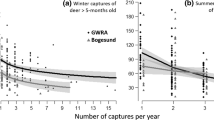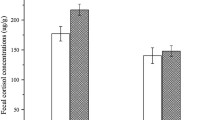Abstract
High stress response is an important factor impeding the breeding of wild animals in captivity. Experimental fawn manipulation is considered a suitable approach to reduce the negative effects of behavioral and physiological stress. The forest musk deer (Moschus berezovskii) is classified as “endangered” by the IUCN Red List due to over-exploitation for musk production. Musk is highly valued for its cosmetic and alleged pharmaceutical properties and has stimulated the enthusiasm of captive musk deer breeding in recent years. This study attempts to reduce behavioral and physiological stress responses in juvenile musk deer using experimental fawn manipulation. Habituation started 5 days after birth and lasted until weaning age (90 days). We determined the behavioral stress response at the age of 30, 60, 90, 150, and 360 days by measuring acceptance or rejection of three treatment intensities (i.e., stroking, embracement) and quantified behavioral responses (urination, approaching the investigator). At the same time, physiological stress parameters were established, measuring the fecal glucocorticosteroid metabolite (FGM) concentration. Our results indicate that fawn manipulation initially reduced the behavioral stress, but after termination of treatments, stress symptoms reoccurred. We detected no difference in the FGM concentrations between treatment and control groups, suggesting that the experimental fawn manipulation did not decrease the physiological stress response. This implies that behavioral stress reduction cannot be sustained if the physiological stress remains unaltered. We argue that the socio-positive reactions of musk deer fawns to humans could be phenotypic and that the physiological stress response rather reflects their intrinsic characteristics than a successful manipulation.




Similar content being viewed by others
References
Andrews RV (1979) The physiology of crowding. Comp Biochem Phys A 63:1–6
Bateson P (1979) How do sensitive periods arise and what are they for? Anim Behav 27:470–486
Becker BG, Lobato JP (1997) Effect of gentle handling on the reactivity of zebu crossed calves to humans. Appl Anim Behav Sci 53:219–224
Boissy A, Bouissou MF (1988) Effects of early handling on heifers’ subsequent reactivity to humans and to unfamiliar situations. Appl Anim Behav Sci 20:259–273
Boivin X, Tournadre H, Le Neindre P (2000) Hand-feeding and gentling influence early-weaned lambs’ attachment responses to their stockperson. J Anim Sci 78:879–884
Denenberg VH (1968) A consideration of the usefulness of the critical period hypothesis as applied to the stimulation of rodents in infancy. In: G. Newton S. Levine (Eds.), Reading in Early Experience and Behavior. Charles C Thomas, Springfield, Ill., pp 142–167
Denenberg VH, Karas GG (1960) Interactive effects of age and duration of infantile experience on adult learning. Psychol Rep 7:313–322
Diamond J (2002) Evolution, consequences and future of plant and animal domestication. Nature 418:700–707
Fletcher TJ (2001) Farmed deer: new domestic animals defined by controlled breeding. Reprod Fertil Dev 13:511–516
Green M, Taylor R (1986) The musk connection. New Sci 110:56–58
Green MJB (1989) Musk production from musk deer. In: Hudson RJ, Drew KR, Baskin LM (eds) Wildlife production system. Cambridge University Press, Cambridge, pp. 401–412
Györkös I, Mézes M, Szücs E, Kovács K, Borka G, Gábor G, Völgyi-Csík J (1999) Behavioural development of Holstein-Friesian cows and calves. Acta Agron Hung 47:39–52
He L (2014) Studies on stress status of captive forest musk deer based on non-invasive methods with reference to application value. PhD thesis, Beijing Forestry University, Beijing, China
He L, Li LH, Wang WX, Liu G, Liu SQ, Liu WH, Hu DF (2014a) Welfare of farmed musk deer: changes in the biological characteristics of musk deer in farming environments. Appl Anim Behav Sci 156:1–5
He L, Wang WX, Li LH, Liu BQ, Liu G, Liu SQ, Hu DF (2014b) Effects of crowding and sex on fecal cortisol levels of captive forest musk deer. Biol Res 47:e48
Hemsworth PH, Barnett JL, Hansen C (1987) The influence of inconsistent handling by humans on the behaviour, growth and corticosteroids of young pigs. Appl Anim Behav Sci 17:245–252
Henning SJ (1978) Plasma concentrations of total and free corticosterone during development in the rat. Am J Physiol Endoc M 235:E451
Homes V (1999) On the scent: conserving musk deer—the uses of musk and Europe’s role in its trade. TRAFFIC Europe, Brussels
Hosey G (2008) A preliminary model of human–animal relationships in the zoo. Appl Anim Behav Sci 109:105–127
Hu Z, Feng X (2007) Effect of artificial nursing of young musk deer. Contemp Anim Husban 5:50–51
Jago JG, Krohn CC, Matthews LR (1999) The influence of feeding and handling on the development of the human–animal interactions in young cattle. Appl Anim Behav Sci 62:137–151
Kessler MR, Turner DC (1997) Stress and adaptation of cats (Felis silvestris catus) housed singly, in pairs and in groups in boarding catteries. Anim Welf 6:243–254
Koolhaas JM, Korte SM, De Boer SF, Van Der Vegt BJ, Van Reenen CG, Hopster H, De Jong IC, Ruis MA, Blokhuis HJ (1999) Coping styles in animals: current status in behavior and stress-physiology. Neurosci Biobehav Rev 23:925–935
Krohn CC, Jago JG, Boivin X (2001) The effect of early handling on the socialisation of young calves to humans. Appl Anim Behav Sci 74:121–133
Kudielkaa BM, Kirschbaum C (2005) Sex differences in HPA axis responses to stress: a review. Biol Psychol 69:113–132
Lang D, Liu W, Wang Y, Tang Y, He L, Liu S, Hu D (2012) Fecal cortisol changes of captive forest musk deer in non-pregnant period with reference to its indicative role. J. Beijing Forestry University 34:81–83
Laule GE, Bloomsmith MA, Schapiro SJ (2003) The use of positive reinforcement training techniques to enhance the care, management, and welfare of primates in the laboratory. J Appl Anim Welf Sci 6:163–173
Levine S (1967) Maternal and environmental influences on the adrenocortical response to stress in weanling rats. Science 156:258–260
Levine S, Haltmeyer GC, Karas GG, Denenberg VH (1967) Physiological and behavioral effects of infantile stimulation. Physiol Behav 2:55–59
Meaney MJ, Aitken DH, Van Berkel C, Bhatnagar S, Sapolsky RM (1988) Effect of neonatal handling on age-related impairments associated with the hippocampus. Science 239:766–768
Meng X, Yang H, Yang Q, Feng Z, Peng X, Perkins GC (2010) Preliminary findings of behavioral patterns in captive alpine musk deer (Moschus sifanicus) and prospects for future conservation. Turk J Vet Anim Sci 34:111–117
Meng X, Zhao C, Hui C, Luan X (2011) Behavioral aspects of captive Alpine musk deer during non-mating season: gender differences and monthly patterns. Asian-Aust J Anim Sci 24:707–712
Mignon-Grasteau S, Boissy A, Bouix J, Faure JM, Fisher AD, Hinch GN, Jensen P, Le Neindre P, Mormède P, Prunet P, Vandeputte M, Beaumont C (2005) Genetics of adaptation and domestication in livestock. Liv Prod Sci 93:3–14
Mills J (1998) Need for further research into tiger bone and musk substitutes agreed. TRAFFIC Dispatches April 1998. TRAFFIC International, Cambridge
Millspaugh JJ, Washburn BE (2004) Use of fecal glucocorticoid metabolite measures in conservation biology research: considerations for application and interpretation. Gen Comp Endocrinol 138:189–199
Moberg GP, Mench JA (2000) The biology of animal stress: basic principles and implications for animal welfare. CAB International, Wallingford
Moberg GP, Wood VA (1982) Effect of differential rearing on the behavioral and adrenocortical response of lambs to a novel environment. Appl Anim Ethol 8:269–279
Morgan KN, Tromborg CT (2007) Sources of stress in captivity. Appl Anim Behav Sci 102:262–302
Mormède P, Andanson S, Aupérin B, Beerda B, Guémené D, Malmkvist J, Manteca X, Manteuffel G, Prunet P, van Reenen CG, Richard S, Veissier I (2007) Exploration of the hypothalamic–pituitary–adrenal function as a tool to evaluate animal welfare. Physiol Behav 92:317–339
Müller P, Eulenberger K (1995) Zur Situation der Moschustiere (Moschus L. 1758) unter besonderer Berücksichtigung der Fortpflanzungsbiologie und der Beobachtungen im Zoologischen Garten Leipzig. Zool Garten 65:209–223
O’Regan HJ, Kitchener AC (2005) The effects of captivity on the morphology of captive, domesticated and feral mammals. Mammal Rev 35:215–230
Price KV (1999) An introduction to differential evolution. In: Corne D et al. (eds) New ideas in optimization. McGraw-Hill Ltd, Maidenhead, pp. 79–108
Price TD (1984) The evolution of sexual size dimorphism in Darwin’s finches. Am Nat 123:500–518
Probst JK, Spengler Neff A, Leiber F, Kreuzer M, Hillmann E (2012) Gentle touching in early life reduces avoidance distance and slaughter stress in beef cattle. Appl Anim Behav Sci 139:42–49
Probst JK, Hillmann E, Leiber F, Kreuzer M, Spengler Neff A (2013) Influence of gentle touching applied few weeks before slaughter on avoidance distance and slaughter stress in finishing cattle". Appl Anim Behav Sci 144:14–21
Sapolsky RM (1986) Glucocorticoid toxicity in the hippocampus: reversal by supplementation with brain fuels. J Neurosci 6:2240–2244
Sapolsky RM (1992) Do glucocorticoid concentrations rise with age in the rat? Neurobiol Aging 13:171–174
Sapolsky RM, Altmann J (1991) Incidence of hypercortisolism and dexamethasone resistance increases with age among wild baboons. Biol Psychiatry 30:1008–1016
Sato S, Shiki H, Yamasaki F (1984) The effects of early caressing on later tractability of calves. Jap J Zootech Sci 55:332–338
Schütz KE, Hawke M, Waas JR, McLeay LM, Bokkers EAM, van Reenen CG, Webster JR, Stewart M (2012) Effects of human handling during early rearing on the behaviour of dairy calves. Anim Welf 21:19
Sheng HL, Liu ZX (2007) The musk deer in China. The Shanghai Scientific & Technical Publishers, Shanghai
Soares JF, Pereira H, Desta FS, Sandouka M, Macasero W (2015) Causes of mortality of captive Arabian gazelles (Gazella arabica) at King Khalid Wildlife Research Center, Kingdom of Saudi Arabia, from 1988 to 2011. J Zoo Wildl Med 46:1–8
Thompson VD (1989) Behavioral response of 12 ungulate species in captivity to the presence of humans. Zoo Biol 8:275–297
Wada H (2008) Glucocorticoids: mediators of vertebrate ontogenetic transitions. Gen Comp Endocrinol 156:441–453
Wada H, Hahn TP, Breuner CW (2007) Development of stress reactivity in white-crowned sparrow nestlings: total corticosterone response increases with age, while free corticosterone response remains low. Gen Comp Endocrinol 150:405–413
Wang Y, Harris RB (2008) Moschus berezovskii. The IUCN Red List of Threateded Species. Version 2014.1. www.iucnredlist.org. Accessed 06 June 2015
Wasser SK, Bevis K, King G, Hanson E (1997) Noninvasive physiological measures of disturbance in the northern spotted owl. Conserv Biol 11:1019–1022
Weinberg J, Levine S (1980) Psychobiology of coping in animals: The effects of predictability. In: Levine S et al. (eds) Coping and Health. NATO Conference Series 12, Plenum Press, New York, pp 39–59
Wemmer C (1998) Deer: status survey and conservation action plan. IUCN/SSC Deer Specialist Group, IUCN, Gland
Wielebnowski NC, Fletchall N, Carlstead K, Busso JM, Brown JL (2002) Noninvasive assessment of adrenal activity associated with husbandry and behavioral factors in the North American clouded leopard population. Zoo Biol 21:77–98
Wu J, Wang W (2007) The musk deer of China. China Forestry Publisher, Beijing
Xu K, Bu S, Liang Z, Wang H, Luo C, Zhu C (2014) Research progress in forest musk deer. Heilongjiang Animal Science and Veterinary Medicine 4:147–150
Yu XJ, Hu DF, Jin XL, Ge XF, Yang LL, Zhao PP, Zhang Q (2011) Non-invasive determination of fecal steroid hormones relating to conservation practice in giant panda (Ailuropoda melanoleuca). Anim Biol 61:335–347
Acknowledgments
The authors would like to thank the Breeding Centre of Forest Musk Deer in Shaanxi Province and Martin Plath and Sun Ping for their comments on a previous version of our manuscript. The research was funded by the Species Salvation Program of the Department of Fauna, Flora and Nature Reserve Management, State Forestry Administration of China (No. Forest musk deer 2012, 2013, 2014, 2015).
Author information
Authors and Affiliations
Corresponding authors
Additional information
Wenxia Wang and Lan He contributed equally to this work.
Rights and permissions
About this article
Cite this article
Wang, W., He, L., Liu, S. et al. Behavioral and physiological responses of forest musk deer (Moschus berezovskii) to experimental fawn manipulation. acta ethol 19, 133–141 (2016). https://doi.org/10.1007/s10211-015-0232-x
Received:
Revised:
Accepted:
Published:
Issue Date:
DOI: https://doi.org/10.1007/s10211-015-0232-x




